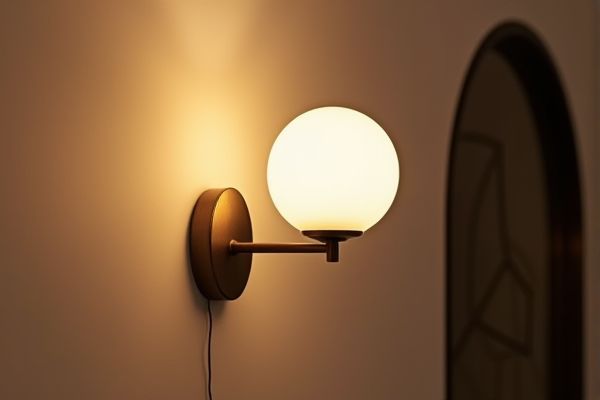
Wall sconces provide ambient or accent lighting with a decorative touch by mounting light fixtures directly on walls, ideal for adding warmth and style to your space. Ceiling downlights offer focused, efficient illumination from above, perfect for general lighting or task areas; explore the rest of the article to discover which option best suits Your lighting needs.
Table of Comparison
| Feature | Wall Sconce | Ceiling Downlight |
|---|---|---|
| Installation Location | Mounted on walls | Mounted on ceilings |
| Light Direction | Typically sideways or upward | Downward focused light |
| Purpose | Ambient and accent lighting | General and task lighting |
| Design Impact | Adds decorative element | Minimalistic, flush with ceiling |
| Installation Complexity | Moderate, requires wall wiring | Moderate to high, requires ceiling wiring and potential remodeling |
| Energy Efficiency | Depends on bulb type, often LED compatible | Highly energy-efficient with LED options |
| Maintenance | Easy access for bulb replacement | May require ladder or professional service |
| Common Uses | Hallways, bathrooms, living rooms | Kitchens, offices, corridors |
Introduction to Wall Sconces and Ceiling Downlights
Wall sconces provide ambient or accent lighting by being mounted on walls, offering decorative and functional illumination in hallways, living rooms, or bedrooms. Ceiling downlights are recessed fixtures installed flush with the ceiling, delivering focused, direct light ideal for task lighting and maintaining a sleek, unobtrusive ceiling appearance. Both lighting types serve distinct purposes in interior design, balancing aesthetics and functionality.
Design and Aesthetic Differences
Wall sconces provide accent lighting that enhances vertical surfaces and creates ambient, decorative effects tailored to your room's style, while ceiling downlights offer focused, uniform illumination ideal for task-oriented spaces. The design of wall sconces often features artistic elements and varied shapes that contribute to the wall's texture and decor, contrasting with the sleek, minimalistic appearance of ceiling downlights which blend seamlessly into ceilings. Choosing between these fixtures depends on whether you prioritize aesthetic appeal and ambient mood or practical, evenly distributed lighting.
Light Distribution: Wall Sconce vs. Downlight
Wall sconces provide ambient or accent lighting with a wide, softer light distribution that highlights walls and architectural features. Ceiling downlights offer focused, direct illumination ideal for task lighting and evenly lighting a room with minimal shadowing. The choice between the two depends on whether the goal is decorative ambiance or functional, concentrated lighting.
Ideal Locations and Applications
Wall sconces are ideal for accent lighting in hallways, living rooms, and bedrooms where they provide soft, ambient illumination without occupying ceiling space. Ceiling downlights are best suited for general task lighting in kitchens, bathrooms, and offices, offering focused, direct light over work areas. Both fixtures enhance spatial functionality, with sconces adding decorative appeal and downlights optimizing brightness.
Installation Requirements and Complexity
Wall sconces generally require mounting brackets, secure wall studs, and potentially new wiring, making installation more complex and often needing professional expertise. Ceiling downlights typically involve cutting holes into the ceiling, accessing existing wiring, and may require insulation-compatible fixtures to meet building codes. Your choice between these lighting options should consider the structural changes and electrical work you're prepared to handle.
Energy Efficiency Comparison
Wall sconces typically use less energy than ceiling downlights due to their focused, ambient illumination that requires lower wattage bulbs. Ceiling downlights often illuminate larger areas, demanding higher wattage and potentially increasing energy consumption. To maximize your energy efficiency, choose LED bulbs for both fixtures and consider dimmable options to reduce unnecessary power usage.
Cost: Upfront and Long-Term
Wall sconces generally have a lower upfront cost compared to ceiling downlights, which often require more complex installation and wiring. Long-term expenses for wall sconces may be reduced due to easier maintenance and replacement, while ceiling downlights can lead to higher energy costs if not equipped with energy-efficient bulbs. Choosing between the two depends on balancing initial budget constraints with anticipated energy consumption and upkeep over time.
Maintenance and Longevity
Wall sconces typically require less frequent maintenance due to their accessible placement and simpler installation, making bulb replacement and cleaning easier compared to ceiling downlights. Ceiling downlights, often recessed and installed in higher or harder-to-reach areas, may necessitate professional servicing for maintenance, potentially increasing upkeep costs. Choosing the right fixture for your space ensures optimal longevity and reduces the hassle of frequent repairs or replacements.
Best Uses for Ambience and Task Lighting
Wall sconces provide soft, indirect lighting ideal for creating a warm ambiance in living rooms, hallways, or bedrooms, enhancing your space with decorative appeal. Ceiling downlights offer focused, direct illumination perfect for task lighting in kitchens, offices, or workshops where bright, concentrated light is essential. Combining both lighting types allows you to achieve a balanced environment that supports both mood setting and functional activities effectively.
Choosing the Right Fixture for Your Space
Wall sconces provide ambient or accent lighting ideal for hallways, living rooms, and reading nooks, enhancing wall space while adding decorative value. Ceiling downlights offer focused, directional illumination suitable for kitchens, bathrooms, and offices, creating an even, shadow-free environment. Selecting the right fixture depends on your room's function, lighting needs, and aesthetic preference for either atmospheric warmth or task-oriented brightness.
 homyna.com
homyna.com